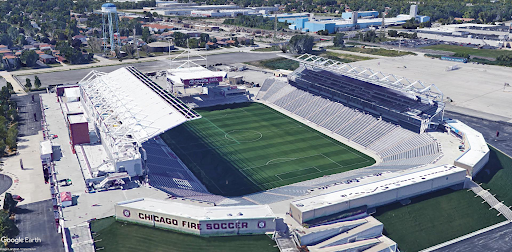
Image: SeatGeek Stadium in Bridgeview (Source: sortitoutsi.net)
Any new major event venue is a logistical puzzle that can’t please everyone. A stadium expected to host 75,000 or more, such as the proposed Bears stadium in Arlington Heights, is a logistical puzzle on steroids. And with only eight or nine home games per year on the NFL schedule, you can assume the strategy will include finding ways to keep it busy on the 350-plus days per year that there won’t be a Bears game. In fact, this climate-controlled facility could become a year-round entertainment mecca unlike any Chicago has ever seen–including A-list concerts, other events too large for the United Center, college bowl games, Final Fours, and even a Super Bowl or two. Given recent trends in megastadiums, that come with an entire district of restaurants, hotels, offices, and shops.
Put it all together, and the stakes are high. How the proposal shakes out could dramatically impact the real estate and development landscape of Arlington Heights for decades to come. Will the Bears’ need to generate event and ancillary revenues overpower the best interests of Arlington Heights, or are they one in the same?
Other Chicagoland venues, especially those that received taxpayer funding, offer cautionary tales. The Chicago Fire moved to Bridgeview’s SeatGeek Stadium in 2006, when Bridgeview excitedly told residents that stadium revenues would cover the cost of the facility. That didn’t happen. Bridgeview bent over backwards to cover stadium debts including an increase in property taxes, the Fire did not build the support they had hoped for, and Seatgeek failed to become a destination in the way both sides had projected. Just 13 years after it opened, the Fire moved back to the city. The area around McCormick Place’s Wintrust Arena has grown rapidly since it opened in 2017, but it’s highly debatable whether or not the arena itself has been a major factor.
The 1988 public financing and planning of the White Sox’s Guaranteed Rate Field was shrouded in controversy as well. Hypotheses abound for why they rarely outdraw their north side counterparts, the stadium hasn’t impacted its surroundings much since it was built. Things feel a world apart on the North Side, where the Cubs spent much of the 2010s acquiring and rebuilding property surrounding Wrigley Field specifically to generate ancillary revenues in ways the Bears may try to emulate. Some laud the modernized amenities, while others decry the loss of decades-old authentic neighborhood character. But did these projects impact surrounding property values, and have they spurred additional development?
It may be too soon to definitely say, but again, the much larger project in Arlington Heights must decide the type of local impact that it wants, and its potential externalities. A key question to sort out is just a few miles down the road: Schaumburg, particularly its existing status as a regional entertainment, office, retail, and hotel hub. Do grandiose plans for Bears stadium-adjacent hotels and entertainment steal Schaumburg’s thunder, or do they prove redundant and fiscal disappointments?
This is a question that Guaranteed Rate Field and the United Center, which have predominantly relied on parking for ancillary revenue over the few decades of their existence, did not have to address. And yet, it could be the vital question to making the math work for the Bears. Bars and restaurants are easy to fill on game days, but attracting customers for them throughout every day is a separate equation. That could require more hotels and office space to increase the daytime population on the site, which brings us back to the question of whether Schaumburg already fulfills those needs. It remains to be seen how the Bears brass would navigate their first foray into commercial real estate.
Not to be lost in the shuffle are Arlington Heights taxpayers, which could greatly benefit from the new amenities, become stuck in their fiscal and vehicular congestion, or a mix of both. It seems as though the Bears’ stadium development plans would be most similar to the Cubs’ Wrigley Field redevelopment, even though in that case the ballpark was obviously already in place. 51 years after the Bears left Wrigley Field, we’ll see if they think the market supports a new, mini Wrigleyville in Arlington Heights.



